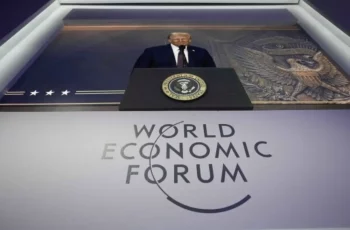The Bank Speaks Through its Center for Geopolitics
J.P. Morgan Chase is the largest bank in the United States. It has a global trends advisory organization called the Center for Geopolitics. The study believes the war’s likely outcome is a mixed deal between Russia and Ukraine without foreign troops or security guarantees. We may be seeing that develop as Steven Witkoff, President Trump’s Special Envoy, heads to Moscow.

The JP Morgan Chase Center in May of this year published a brief study titled “The Russia-Ukraine Endgame and the Future of Europe.” The authors were Derek Chollet who is the managing director and head of the Center, and Lisa Sawyer, Executive Director for Geopolitics. Both Chollet and Sawyer served under Joe Biden at the Defense Department and in Chollet’s case, also at the State Department. Both are confirmed Atlanticists and liberal in outlook. While not explicitly stated, both served during the time the US was supporting Ukraine with tens of billions in military assistance and money to pay government employees in Ukraine, underwrite soldier’s pensions, and reconstruction assistance.
While the Endgame study received hardly any notoriety or interest in the United States, it was taken very seriously by Ukraine’s leadership. The “scenarios” adduced in the study formed an important part of a recent interview with Kiril Budanov, head of Ukraine’s Main Directorate of Intelligence (GUR). The GUR is organized under the Ukrainian Ministry of Defense. Budanov is regarded as one of the toughest and smartest operators in Ukraine and his organization has carried out assassinations and bombings in Russia and elsewhere.
The study “predicted” that some sort of deal between Ukraine and Russia would be done by the end of Q2 (end of June, 2025). That prediction was, of course, wrong. Even so, the study offered four “possible outcomes” for the endgame and suggested the likelihood, expressed in percentage terms, for each of the outcomes.
The four outcomes are: the Best Case is called the “South Korea” model. The authors give it a 15% probability for adoption. The second scenario the author’s call “Israel.” It has a 20% chance of success. The third outcome is called “Georgia,” which the author’s say has a 50% chance of being accepted. Finally there is the fourth outcome, “the worst case” which the author’s called “Belarus.”
The South Korea outcome does not see Ukraine getting back any of its territory under Russian control. However, the South Korea model anticipates the presence of a European tripwire military force “backstopped by an American security guarantee.” In this “best case” Ukraine keeps 80% of its territory leading to a stable outcome for Ukraine. One version of the South Korea outcome is that the $300 billion in Russian frozen assets would be used for reconstruction in Ukraine. The deal resembles South Korea because the US and others serve as a tripwire for North Korea and because the South Korean economy is booming.
The South Korea outcome is unlikely to be acceptable to Russia because it would keep NATO-like forces in Ukraine. It would also take Russian assets and use them to compensate Ukraine, something Russia will not accept. It also leaves the actual territorial issue unsettled and unsolved, meaning that Ukraine would not be compelled to accept the loss of territory to Russia. As written the scenario says nothing about Western sanctions. Finally, the war could restart on any day and would quickly become a war in Europe, not just Ukraine. The South Korea option, therefore, would be a problem not only for Russia, but also for Europe and the United States, and in fact would even be worse than NATO which requires consensus to activate Article 5 of the NATO collective defense treaty.
The second outcome, dubbed “Israel” by the authors, would not have the tripwire troop presence on Ukrainian soil. According to the authors, it would have a 20% chance of adoption by the warring parties. Otherwise this option, which the author’s say is “Still OK” offers nothing to Russia and, as the author’s say, regarding Ukraine “war would always be on its doorstep.” The author’s do suggest that maybe Putin would go along with it if there was sanction’s relief. The second outcome, therefore, won’t do Ukraine any good unless there are real assurances, including assurances on arms supplies, cash for the government, and some integration into Europe’s economy. It is impossible for the US to give financial guarantees without either a Treaty with Ukraine and Congressional approval which would attempt to bind future Congressional decisions. A Treaty needs a two-thirds vote in the US Senate. While a Treaty might be drafted, it is likely to encounter amendments and delays in execution. In this connection it is worth noting that Israel has no written American guarantees, and aid to Israel requires annual Congressional approval.
The third outcome the author’s call “Georgia.” The author’s say it has a 50% chance of being adopted. This scenario rules out foreign troops and other security and financial guarantees. It would potentially include a package of reconstruction assistance (but not the frozen Russian assets). Ukraine would not be integrated either into the European Union nor NATO. The author’s think that if the Georgia outcome wins out, Ukraine will drift inexorably into the Russian orbit, for trade reasons among others. The authors argue that “Restrictions on military size [a Russian demand–SDB] and capacity –if part of a negotiated settlement– could prematurely stifle Ukraine’s dynamic defense and tech sectors, erasing a potential engine of postwar growth.”
Before the war, Ukraine had an energetic and relatively low cost tech sector, especially software development. European and Israeli companies subcontracted with Ukraine’s tech sector. Some of this sector, because of the war, has been working on military projects. However, there is no reason why the military sector is the only possible route for hi tech employment for Ukraine –indeed, the commercial sector generally pays better and is often more dynamic than military projects. Moreover, some of the skills developed on military projects, such as artificial intelligence, are highly prized these days and certainly sought after in global markets.
The Georgia outcome, to work, would need hard agreements on territories, borders, trade and related issues along with sanctions relief and other confidence building measures for both of the main parties. It would have to include a step back by NATO, something that will be hard to swallow for the ideologically committed Europeans.
The final outcome the author’s dub as “Belarus” and is the “worst case.” Its two main features are that the US abandons Ukraine and Europe can’t fill in on its own. The author’s say that Russia would seek Ukraine’s “total capitulation” (whatever that means) that would “turn the country into a vassal state of Moscow.” While Russia has a list of demands, one of them is not to demand a “total capitulation” of Ukraine. Like the first outcome “South Korea” and fourth outcome “Belarus” has, according to the authors, a 15% chance as the winning outcome.
As Kiril Budanov commented in his interview, there are many other scenarios than the four posited by J.P. Morgan Chase. Yet the most interesting part of the J.P. Morgan Chase report is that the foreign policy establishment, as represented by the authors (not at all by the Trump administration) are laser focused on the “Georgia” outcome, so much so that if there is a deal struck, the deal will resemble that model. It is another way of saying, without saying so, that the Russians are winning and this is probably the best that can be hoped for under the circumstances.
This week (August 4, 2025) Russia is expecting the arrival soon of Steven Witkoff, President Trump’s Special Envoy. According to President Trump, the Russians asked for the meeting. Last week, Russian foreign minister Sergey Lavrov, said negotiations between Russia and the US are “yielding results.” President Trump wants a ceasefire, something Russia has resisted. Will the Georgia option be on the table, or something else?
Source: author’s blog










Comments